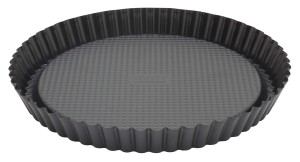When I started baking breads last Christmas holiday, it was mostly because I wanted to know if I could make three particular products: a foccaccia (to revive a memory from an amorous holiday trip with my girlfriend, now wife), a “limburgse kersenvlaai” (a cherry pie) and a “limburgse rijstevlaai” (a pie with rice & egg filling).
I made the foccaccia long ago (and like it a lot), the cherry pie a few weeks ago and last weekend I created the final one on my “bucket list”: the “rijstevlaai“.
Both pies are made with enriched bread dough. In the old days (centuries ago) fruit pies were a way to preserve the produce of the land (grain, fruits, eggs, milk) in the region where I was born: Limburg in the southern Netherlands. Rice pies were an influence of the Spaniards invading the southern part of the Netherlands and Belgium in the 80-year war.
The rice pie is relatively complex to make because it needs the right mix of ingredients to produce a good filling: the cooked rice must be exactly moist and sweet enough.
I must say, the result is great! It’s just a shame that nobody in the family likes it… it’s a typical “Limburgian” treat and the “Hollenders” have a hard time appreciating the taste.
Here is the recipe for those who want to try and repeat it. I took it from an old recipe book (Vlaai en ander Limburgs gebak van Wil en Netty Engels – Geurts) and adapted it slightly (less egg, less sugar).
Ingredients
The dough:
- 250 gr flour
- 6 gr fast-action yeast
- 1 dl milk
- 25 gr butter (soft)
- 15 gr caster sugar
- 4 gr salt
The filling:
- 1 liter full cream milk
- 100 gr pudding rice
- 100 gr caster sugar (70 gr for the rice and 30 gr for the egg mix)
- 10 gr cornstarch
- 3 eggs (large, ~200 gr total)
Instructions
Preparation of the filling:
- Bring the milk to a boil in a pan with a thick bottom, and add the rice and the sugar. Let it come back to a boil, stirring constantly;
- Turn down the heat as much as you can, cover the pan with a lid and let the rice cook until tender (about 1 hour). Stir the mixture occasionally.
- Make sure the rice grains are tender and that the rice porridge is thick enough;
- If you still see some unbound milk in the pan, take 5 to 10 gr cornstarch , mix with a little cold milk and add to the rice while stirring; bring the rice back to a boil and keep it at boiling point for a little bit while stirring constantly;
- Then take the pan from the fire;
- Let the rice cool down a bit.
Preparation of the dough :
- Mix the flour in a bowl with the melted butter, sugar, yeast, milk (I use my hands, not a machine), until it comes together as a rough ball after 2 minutes;
- Then add the salt and knead into a smooth and elastic dough for 8-10 minutes;
- Form the dough into a ball and place in a greased bowl; cover with clingfilm and let rise for about 1 hour (until doubled in size).
Creating the pie:
The dough:
- Transfer the dough to your workbench, gently press the air out with the knuckles of your fists and use a rolling pin to flatten it into a circle of 3 mm thickness that is larger in diameter than the flan tin (28-30 cm tin);
- Gently place the dough flap into the greased flan tin. Make sure the dough can bounce back and a piece hangs over the edge;
- Roll along the sharp edge of the tin with the rolling pin to remove the excess dough;
- Prick holes in the the dough with a fork to prevent air pockets while baking, and place the tin in a warm place to rise (the dough becomes thick and fluffy).
The filling:
- Separate the eggs into yolks and whites and mix the yolks with 30 g sugar until frothy; Beat the egg whites until stiff;
- Spoon the egg yolk / sugar mixture into the cooled rice porridge;
- Then fold half of the egg whites carefully through the rice mixture;
- Spread half of the rice mixture onto the bottom of the pie;
- Fold the rest of the egg whites gently through the remaining rice;
- Then spread this again over the pie.
The baking:
- Pre-heat the oven to 220°C;
- Place the pie in the middle of the oven and bake for 25 to 30 minutes. The pie is done when the filling and the bottom are brown and the dough separates from the tin.
- Remove the pie from the oven. Carefully lift it out of the tin and place on a cooling rack.
Don’t cut the pie until it is completely cold.
The rijstevlaai is baked in a tin like this one:
Note: I posted this earlier on Google+’s “the art of bread” community where it was not visible for everyone.
Enjoy! Eric


Recent comments